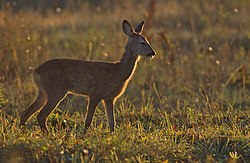用户:Kivary/roedeer
| 西方狍 | |
|---|---|

| |
| 雄性及雌性的西方狍 | |
| 科学分类 | |
| 界: | 动物界 Animalia |
| 门: | 脊索动物门 Chordata |
| 纲: | 哺乳纲 Mammalia |
| 目: | 偶蹄目 Artiodactyla |
| 科: | 鹿科 Cervidae |
| 属: | 狍属 Capreolus |
| 种: | 西方狍 C. capreolus
|
| 二名法 | |
| Capreolus capreolus | |

| |
| 西方狍之分布范围 | |
西方狍(Capreolus capreolus)是一种分布于欧洲、里海及安那托利亚的鹿,故被命名为西方狍。该物种有一种名叫东方狍(Capreolus pygargus)的近亲,主要分布于中东、中国及西伯利亚等地方。为夜行性动物,主要进食果实等食物为生。The two species meet at the Caucasus Mountains, with the European species occupying the southern flank of the mountain ranges and adjacent Asia Minor and the Siberian species occupying the northern flank of the mountain ranges. Within Europe, the European Roe Deer occurs in most areas, with the exception of northernmost Scandinavia (north of Narvik) and some of the islands, notably Iceland, Ireland, and the Mediterranean Sea islands; in the Mediterranean region it is largely confined to mountainous regions, and is absent or rare at low levels.
命名学
[编辑]English roe is from Old English raha, from Proto-Germanic *raikhon, cognate to Old Norse ra, German Reh. The word is attested in the 5th century Caistor-by-Norwich astragalus inscription as raïhan. Ultimately perhaps from a PIE root *rei- "streaked, spotted."
形态
[编辑]
西方狍身长95-135 厘米(3.1 - 4.4 尺),膊头阔65-75 厘米(2.1 - 2.5 尺),体重约15-30 公斤(33-66 磅),在鹿科动物中属于体型较小的物种。它有着短小和直竖的叉角,更有带红色的身体及灰白色的脸。西方狍善于伪装,在夏天时会呈金红色作伪装;冬天时身体变会黑化,呈啡色甚至是黑色,及加上白色的臀部。另外,它仅短2-3 厘米(0.8 - 1.2 寸)的尾巴短得几乎看不到,这亦有助隐藏自己。 西方狍的第一和第二对的叉角都没有分叉,长度亦较短(5-12 厘米,即 2 - 4.7 寸),但当雄鹿在良好的情况下发育时,叉角便会增高至20-25厘米(8 - 10寸),并长出二至三个分叉,罕见的甚至有四个。When the male's antlers begin to regrow, they are covered in a thin layer of velvet-like fur which disappears later on after the hair's blood supply is lost. Males may speed up the process by rubbing their antlers on trees, so that their antlers are hard and stiff for the duels during the mating season. Unlike most cervids, roe deer begin regrowing antlers almost immediately after they are shed.
栖息及捕猎
[编辑]
西方狍一般在黄昏时间迅速而优雅地活动,主要生活在树林中,偶尔也在草原和稀疏的森林里活动。主要以草、树叶、浆果和嫩枝为食,尤其喜欢湿润的嫩草,例如雨后第二天的草。 Roe deer will not generally venture in to a field that either has livestock in it (ie. sheep, cattle), or has recently had it in; this is because the livestock will make the grass very unclean. A pioneer species commonly associated with biotic communities at an early stage of succession, during the Neolithic period in Europe the Roe Deer was abundant, taking advantage of areas of forest or woodland cleared by Neolithic farmers (Boyle, 2006).


生命周期
[编辑]一般来说,西方狍在野外生存最长的寿命为十年。当它们生命快要结束时,它们会像狗一样的叫及亮出其白色的臀部。Rump patches differ between the sexes, with the white rump patches heart-shaped on females and kidney-shaped on males. Males may also bark, make a low grunting noise or make a high pitched wolf-like whine when attracting mates during the breeding season, often luring multiple does into their territory. The Roe Deer spends most of its life alone, preferring to live solitary except when mating during the breeding season.
繁殖
[编辑]The polygamous Roe Deer males clash over territory in early summer and mate in early fall. During courtship, when the males chase the females, they often flatten the underbrush leaving behind areas of the forest in the shape of a figure eight called 'roe rings'. Males may also use their antlers to shovel around fallen foliage and dirt as a way of attracting a mate. Roebucks enter rutting inappetence during the July and August breeding season. Females are monoestrous and after delayed implantation usually give birth the following June, after a ten-month gestation period, typically to two spotted fawns of opposite sexes. The fawns remain hidden in long grass from predators until they are ready to join the rest of the herd; they are suckled by their mother several times a day for around three months. Roe deer adults will often abandon their young if they sense or smell that an animal or human has been near it. Young female roe deer can begin to reproduce when they are around 16 months old.
参见条目
[编辑]参考文献
[编辑]- ^ Lovari, S., Herrero, J., Conroy, J., Maran, T., Giannatos, G., Stübbe, M., Aulagnier, S., Jdeidi, T., Masseti, M, Nader, I., de Smet, K. & Cuzin, F. Capreolus capreolus. The IUCN Red List of Threatened Species 2008. [10 April 2009]. Database entry includes a brief justification of why this species is of least concern.
- Prior, Richard 1995. The Roe Deer : Conservation of a Native Species (Swan-Hill Press) is regarded as the definitive work on roe deer in Great Britain.
- 'Animal: The Definitive Visual Guide to the World's Wildlife, DK Adult Publishing, (2001), pg. 241.
- Boyle, K.V. 2006. Neolithic wild game animals in Western Europe: The question of hunting, pp 10 - 23. In Animals in the Neolithic of Britain and Europe, Serjeantson, D, and Field, D (eds). Oxbow Books: Oxford.
- Lyneborg, L. (1971). Mammals. ISBN 0-7137-0548-5.
- Reader's Digest, The Wildlife Year, p. 228, ISBN 0-276-42012-8.
- ジュリエット・クラットン・ブロック、ダン・E・ウィルソン 著 ‘ネイチャー・ハンドブック : 世界哺乳类図鉴’ 新树社、2005年、ISBN 4-7875-8533-9。339页。

